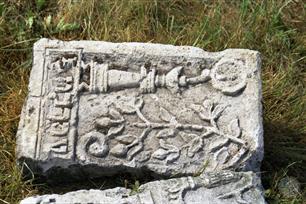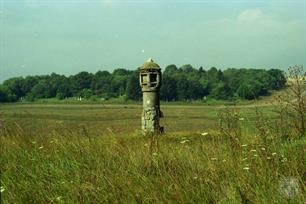Holohory
Zolochiv district, Lviv region
Year - Total Population - Jews
1765 - (?) - 498*
1880 - 2,766 - 1,216
1900 - 3,083 - 1,130
1921 - 2,447 - 505
*In addition to 133 residents of neighboring villages
1765 - (?) - 498*
1880 - 2,766 - 1,216
1900 - 3,083 - 1,130
1921 - 2,447 - 505
*In addition to 133 residents of neighboring villages
Sources:
- Pinkas Hakehillot Polin: Encyclopedia of Jewish Communities, Poland, Volume II, page 137-138, published by Yad Vashem, Jerusalem. Translated by David Goldman, JewishGen, Inc.
Photo:
- Boris Khaimovich, Center for Jewish art. Holohory (Gologуry, Goligur)
- Pinkas Hakehillot Polin: Encyclopedia of Jewish Communities, Poland, Volume II, page 137-138, published by Yad Vashem, Jerusalem. Translated by David Goldman, JewishGen, Inc.
Photo:
- Boris Khaimovich, Center for Jewish art. Holohory (Gologуry, Goligur)
Chronicles from the 12th century mention a village with the name of Gologуry (ukr. Holohory, Гологори). The earliest mention of the town as a private town of the aristocracy is found in documents from 1461. In the 17th and 18th centuries Gologуry was known for its livestock and horse fairs held there. The large estate surrounding Gologуry (including some 5,000 dunams of forest) was owned by the Dominican monastery in Pudkamein. During World War I most of the houses in the center of town were destroyed by the Russians. Repairs were made on some of them between the two wars.
The earliest information about Jews in Gologуry is from 1470. In the 1570s the Jews paid 18 gold pieces as a head tax.
In the beginning of the 16th century a synagogue was built, and in the 18th century there is mention of the Jews of Gologуry as merchants participating in the local fairs.
In 1767 royal treasury ordered the Jewish community to expedite repayment of debts, including both principal and interest to creditors (evidently the municipality).
The Jewish community grew in the 19th century, and reached its peak in population in the 1870s. However, it began to decline thereafter because of emigration to larger centers and to foreign countries.
During World War I Russian soldiers killed more than 100 Jews, and at the end of the war the Joint Distribution Committee assisted in rehabilitating the remaining Jews of Gologуry, which had declined by 41% since the outbreak of the war.
During the 17th and 18th centuries the Jews earned their livelihoods from leasing, taverns, bars, commerce (especially at cattle fairs) and as laborers.
In the 19th century the number of small merchants increased, as did peddlers and various types of craftsmen.
After World War I, approximately 15 workshops employing some 60 people, mostly the owners and their families, were rebuilt.
In 1929 a free loan fund supported by the Joint was established.
In 1935-36 this fund provided 45 loans to merchants and artisans totaling 3,487 zlotys.
The earliest information about Jews in Gologуry is from 1470. In the 1570s the Jews paid 18 gold pieces as a head tax.
In the beginning of the 16th century a synagogue was built, and in the 18th century there is mention of the Jews of Gologуry as merchants participating in the local fairs.
In 1767 royal treasury ordered the Jewish community to expedite repayment of debts, including both principal and interest to creditors (evidently the municipality).
The Jewish community grew in the 19th century, and reached its peak in population in the 1870s. However, it began to decline thereafter because of emigration to larger centers and to foreign countries.
During World War I Russian soldiers killed more than 100 Jews, and at the end of the war the Joint Distribution Committee assisted in rehabilitating the remaining Jews of Gologуry, which had declined by 41% since the outbreak of the war.
During the 17th and 18th centuries the Jews earned their livelihoods from leasing, taverns, bars, commerce (especially at cattle fairs) and as laborers.
In the 19th century the number of small merchants increased, as did peddlers and various types of craftsmen.
After World War I, approximately 15 workshops employing some 60 people, mostly the owners and their families, were rebuilt.
In 1929 a free loan fund supported by the Joint was established.
In 1935-36 this fund provided 45 loans to merchants and artisans totaling 3,487 zlotys.
Until 1772 Gologуry was part of the community of Lvov, but then became independent that same year. The rabbis who served in Gologуry in the 18th century were: Rabbi Zvi Hirsh Geller, the author of Ohr Zvi (he served later as rabbi in Ushitza and as the head of the yeshiva in Brody), who died in 1766; Rabbi Anshel of Tismitz, the author of Mayim Adirim, who served as head rabbi in Lvov (1762); in the first years of the 19th century R. Yosef-Ezriel, son of Chaim-Aryeh-Leibush Rulig served as rabbi. He then went to serve in Sadigora and died there in 1856.
In approximately 1835 Rabbi Yoel, son of Moshe David Ashkenazi, was appointed rabbi of Gologуry. He authored rabbinical responsa.
In 1845 R. Yoel was in Khodorov, and in 1855 he servied in Zlotchov, where he died in 1907. He was followed in 1885 as rabbi of Gologуry by R. Eliezer, son of Berl-Segal Mishel, who servied until 1909 when he moved to Turka, where he remained until his death in 1938. R. Eliezer authored Mishnat Eliezer in two volumes.
In 1910 Rabbi Mordechai-Aryeh Haber was appointed rabbi. During World War I he escaped to Vilna and never returned to Gologуry.
In 1927 Rabbi Shlomo Shikler was appointed rabbi, and subsequently moved to Kalush. He was succeeded by the last rabbi of Gologуry, R. Yosef-Mordechai Bloom (who died in the Holocaust).
In 1895 a Jewish school founded by Baron Hirsch was established in town, and the school received government rights in 1901. Both Jews and non-Jews studied at this school. The children manufactured cans and as payment received free tuition.
The school existed until World War I.
At that time the first Zionist groups in Gologуry were organized in the Zion association. It is also reported that a branch of the Mizrachi was established in town in 1908, and continued to function in the inter-war years.
In 1925 a branch of the Ezra organization was established in Gologуry, as was a branch of the General Zionists and its Zionist youth group.
In the elections to the Zionist congresses, votes were divided between Mizrachi and the General Zionists. In 1933 the results were 15 votes for Mizrachi and 21 votes for the General Zionists, while in 1935 the Mizrachi received 34 votes and the General Zionists 35.
In 1923 a Jewish Association of Public and High Schools was established and offered courses in Hebrew and general occupational training.
This small Jewish community was destroyed by the Nazis. In January 1942 there were 575 Jews in Gologуry. They were expelled in November 1942 to nearby Zlotchov. Apparently some of the Jews in Gologуry were killed during this operation.
In approximately 1835 Rabbi Yoel, son of Moshe David Ashkenazi, was appointed rabbi of Gologуry. He authored rabbinical responsa.
In 1845 R. Yoel was in Khodorov, and in 1855 he servied in Zlotchov, where he died in 1907. He was followed in 1885 as rabbi of Gologуry by R. Eliezer, son of Berl-Segal Mishel, who servied until 1909 when he moved to Turka, where he remained until his death in 1938. R. Eliezer authored Mishnat Eliezer in two volumes.
In 1910 Rabbi Mordechai-Aryeh Haber was appointed rabbi. During World War I he escaped to Vilna and never returned to Gologуry.
In 1927 Rabbi Shlomo Shikler was appointed rabbi, and subsequently moved to Kalush. He was succeeded by the last rabbi of Gologуry, R. Yosef-Mordechai Bloom (who died in the Holocaust).
In 1895 a Jewish school founded by Baron Hirsch was established in town, and the school received government rights in 1901. Both Jews and non-Jews studied at this school. The children manufactured cans and as payment received free tuition.
The school existed until World War I.
At that time the first Zionist groups in Gologуry were organized in the Zion association. It is also reported that a branch of the Mizrachi was established in town in 1908, and continued to function in the inter-war years.
In 1925 a branch of the Ezra organization was established in Gologуry, as was a branch of the General Zionists and its Zionist youth group.
In the elections to the Zionist congresses, votes were divided between Mizrachi and the General Zionists. In 1933 the results were 15 votes for Mizrachi and 21 votes for the General Zionists, while in 1935 the Mizrachi received 34 votes and the General Zionists 35.
In 1923 a Jewish Association of Public and High Schools was established and offered courses in Hebrew and general occupational training.
This small Jewish community was destroyed by the Nazis. In January 1942 there were 575 Jews in Gologуry. They were expelled in November 1942 to nearby Zlotchov. Apparently some of the Jews in Gologуry were killed during this operation.

- Home
- Shtetls
- Vinnytsia region
- Volyn region
- Dnipro region
- Donetsk region
- Zhytomyr region
- Zakarpattia region
- Zaporizhzhia region
- Ivano-Frankivsk region
- Kyiv region
- Kropyvnytskyi region
- Luhansk region
- Lviv region
- Mykolayiv region
- Odessa region
- Poltava region
- Rivne region
- Sumy region
- Ternopil region
- Kharkiv region
- Kherson region
- Khmelnytskyi region
- Chernihiv region
- Chernivtsi region
- Cherkasy region
- Crimea
- Synagogues
- Cemeteries
- Objects & guides
- Old photos
- History
- Contact
Jewish towns of Ukraine
Jewish towns of Ukraine
My shtetl
My shtetl
Donate


